Northern Trust Bundle
Who Really Owns Northern Trust Company?
Unraveling the Northern Trust SWOT Analysis reveals the intricate web of ownership that shapes this financial powerhouse. Understanding "Who owns Northern Trust" is key to grasping its strategic moves and long-term vision. Ownership structures often dictate a company's trajectory, influencing everything from risk management to market expansion.
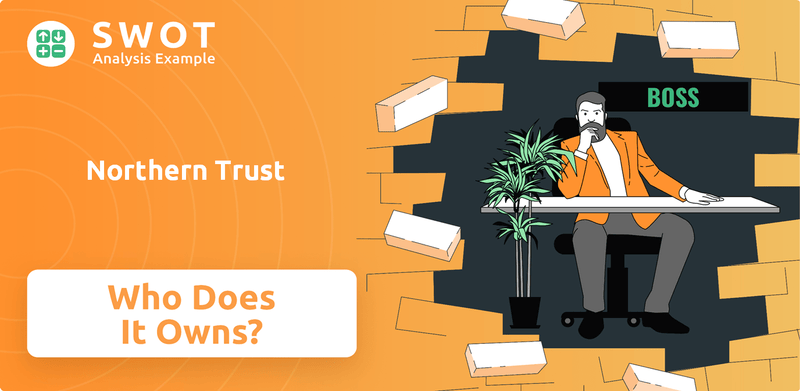
Delving into "Northern Trust ownership" unveils a fascinating history, starting with its roots in Chicago. Examining "Northern Trust shareholders" and "Northern Trust executives" provides insight into the company's governance and decision-making processes. This exploration will illuminate how the company's ownership structure has evolved, impacting its financial performance and strategic direction over time, and answer questions like "Is Northern Trust a publicly traded company?" and "Who are the major shareholders of Northern Trust?".
Who Founded Northern Trust?
The Northern Trust Company, a prominent financial institution, was established on August 12, 1889. The company's origins are rooted in Chicago, founded by Byron Laflin Smith, a respected figure in the banking sector. Smith's vision laid the groundwork for a firm that would become a significant player in the financial world.
Byron Laflin Smith initiated the bank with an initial capitalization of $1 million. He personally contributed a substantial portion, owning 40% of the initial capital. This demonstrated his strong commitment to the venture. On its opening day, the bank began with modest beginnings, recording just 7 accounts and deposits totaling $137,981.25.
The early ownership structure of Northern Trust included a group of 27 shareholders. These individuals were a mix of prominent businessmen and civic leaders. Their involvement was crucial in the early days, reflecting a shared vision of providing trust and banking services to Chicago's growing population.
Among the early shareholders of Northern Trust were notable figures. These individuals played a crucial role in shaping the company's initial direction and success.
- Marshall Field, a well-known businessman.
- Martin A. Ryerson, another significant business leader.
- Philip D. Armour, a prominent figure in the meatpacking industry.
- These early stakeholders helped establish the company's reputation and financial stability.
Northern Trust SWOT Analysis
- Complete SWOT Breakdown
- Fully Customizable
- Editable in Excel & Word
- Professional Formatting
- Investor-Ready Format
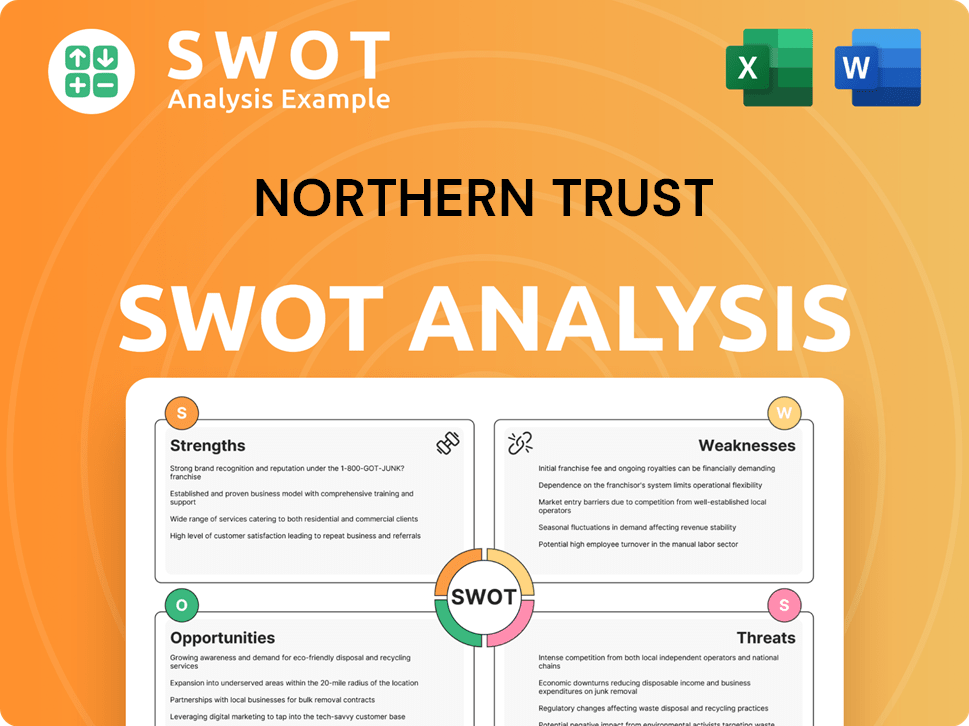
How Has Northern Trust’s Ownership Changed Over Time?
The evolution of ownership for the Northern Trust Company began in 1971 when Northern Trust Corporation was established in Delaware. This entity then acquired nearly all outstanding capital stock of The Northern Trust Company, its main subsidiary. This restructuring marked a pivotal moment, with Northern Trust's stock commencing trading on The Nasdaq Stock Market (NTRS) on February 5, 1971, the very first day of Nasdaq trading. This transition to a publicly traded structure significantly broadened the shareholder base and set the stage for future ownership dynamics.
The ownership structure of Northern Trust has evolved over time, with institutional investors currently holding a substantial portion of the shares. Understanding the major stakeholders provides insight into the company's governance and strategic direction. The ownership structure reflects a widely dispersed model, typical of large public corporations where institutional investors play a significant role.
| Shareholder | Shares Held (as of March 31, 2025) | Percentage Ownership (as of March 31, 2025) |
|---|---|---|
| The Vanguard Group, Inc. | 22,405,202 | 11.57% |
| Fmr Llc (Fidelity Management & Research Company LLC) | 17,542,571 | 6.92% |
| BlackRock, Inc. | 15,366,789 | 7.90% |
| State Street Corp | 9,462,897 | 4.86% |
| Massachusetts Financial Services Co /Ma/ | 7,850,088 | 4.04% |
| PRIMECAP Management Co/Ca/ | 6,523,009 | 3.35% |
As of May 2025, institutional investors hold a significant majority of Northern Trust's shares, with institutional ownership at 85.78%. Mutual funds own 66.90% of the shares as of May 2025. The Smith family, descendants of founder Byron Laflin Smith, reportedly holds approximately 1% of the shares as of February 2025. For more details, a Brief History of Northern Trust provides further context.
Northern Trust's ownership is predominantly held by institutional investors, indicating a stable and widely distributed shareholder base.
- The Vanguard Group, BlackRock, and Fidelity are among the largest institutional shareholders.
- The Smith family, descendants of the founder, maintains a notable, though smaller, stake.
- Understanding the major shareholders is crucial for assessing corporate governance and strategic direction.
- The company's stock has been publicly traded since 1971, expanding its investor base.
Northern Trust PESTLE Analysis
- Covers All 6 PESTLE Categories
- No Research Needed – Save Hours of Work
- Built by Experts, Trusted by Consultants
- Instant Download, Ready to Use
- 100% Editable, Fully Customizable
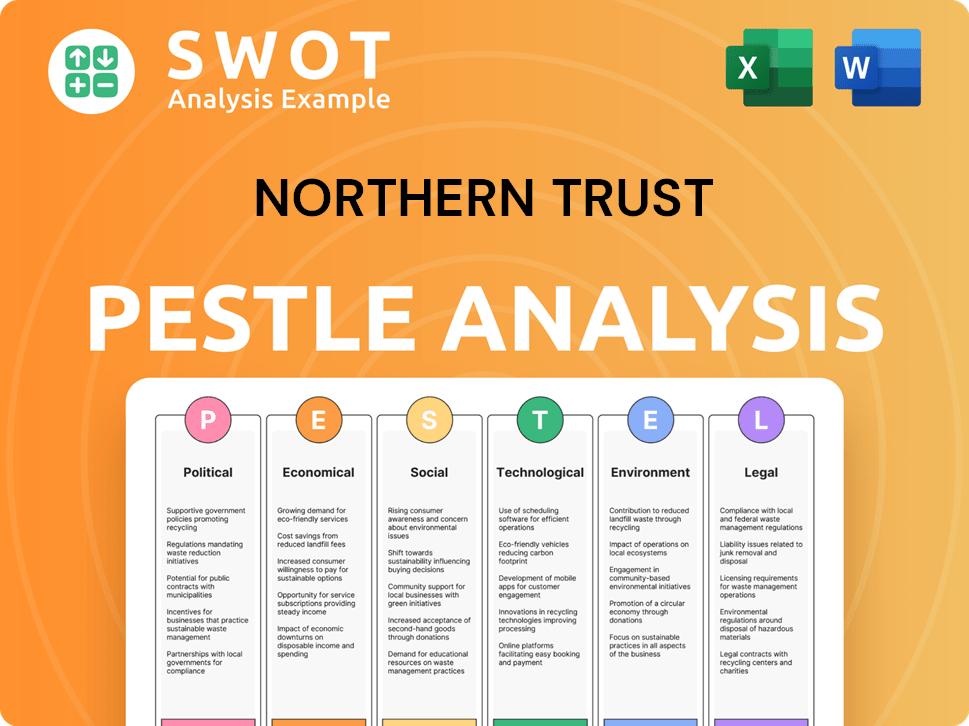
Who Sits on Northern Trust’s Board?
The governance of Northern Trust Company is overseen by its board of directors, who are crucial in the company's strategic direction. While specific details on each board member's representation (major shareholders, founders, or independent seats) are not fully detailed in the provided information, the 2025 Annual Meeting of Stockholders proxy statement, incorporated by reference in the 2024 Form 10-K, will provide this information. This structure ensures accountability and oversight in managing the company's operations and financial performance. The board's composition and activities are key to understanding Northern Trust's overall corporate governance framework.
The board's responsibilities include setting strategic direction, overseeing risk management, and ensuring compliance with regulations. The company's commitment to sound governance is reflected in its board's structure and practices, which are designed to protect shareholder interests and promote long-term value creation. Investors interested in the company's ownership structure can find more insights within the annual reports and proxy statements.
| Aspect | Details | Relevance |
|---|---|---|
| Voting Structure | One-share, one-vote basis for common stock. | Ensures equitable voting rights for shareholders. |
| Proxy Voting Choices | New options launched by Northern Trust Asset Management in August 2024. | Provides clients with greater control over their proxy voting preferences. |
| Voting Guidelines | Clients can choose from four voting guideline options. | Allows alignment of proxy votes with investment goals and values. |
Northern Trust operates on a one-share, one-vote basis for its common stock, as stated in its Restated Certificate of Incorporation. This approach ensures that each share of stock carries equal voting power, promoting fairness among shareholders. In August 2024, Northern Trust Asset Management introduced new proxy voting choices for its clients in pooled funds, reflecting a broader industry trend towards greater customization in stewardship. This initiative allows clients to select from four voting guideline options, including Northern Trust's in-house guidelines, which empowers institutional asset owners to align their proxy votes with their investment objectives. This is one of the many ways Marketing Strategy of Northern Trust is adapting to meet the evolving needs of its clients.
Northern Trust's governance is structured to ensure shareholder interests are protected.
- The board of directors oversees the company's strategic direction and financial performance.
- Voting rights are based on a one-share, one-vote system.
- Clients have new proxy voting choices to align with their investment goals.
- The company generally votes against proposals that limit management's flexibility.
Northern Trust Business Model Canvas
- Complete 9-Block Business Model Canvas
- Effortlessly Communicate Your Business Strategy
- Investor-Ready BMC Format
- 100% Editable and Customizable
- Clear and Structured Layout
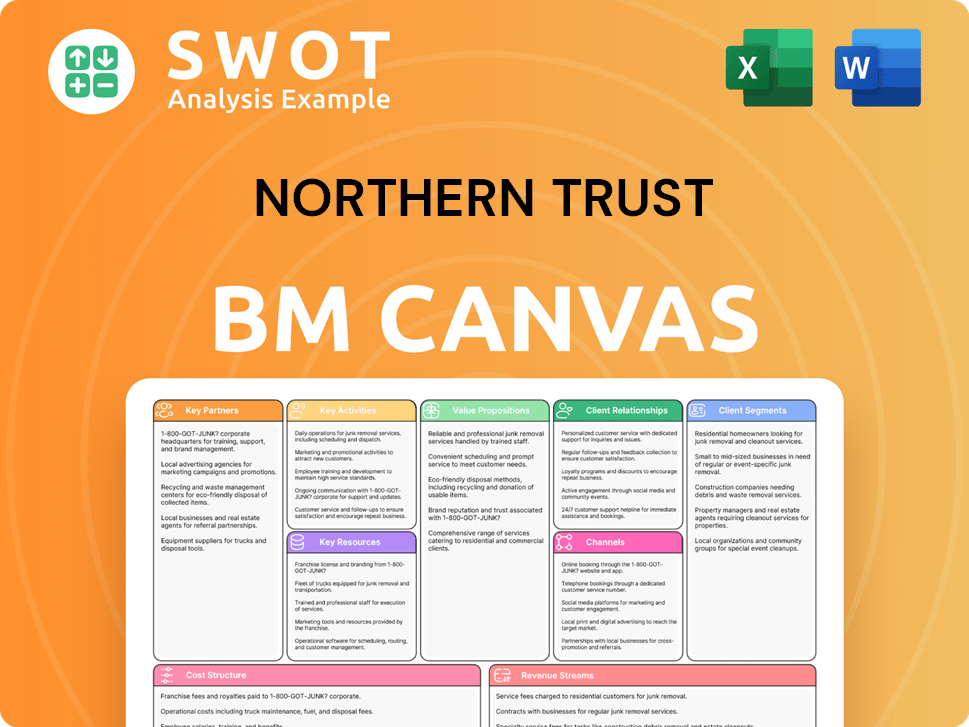
What Recent Changes Have Shaped Northern Trust’s Ownership Landscape?
Over the past few years, the ownership structure of Northern Trust has remained relatively stable, with a strong emphasis on institutional investors. As of May 2025, institutional investors hold a substantial 85.78% stake in the company, reflecting a consistent trend in the financial sector. Insider holdings, although minor, have seen a slight decrease, moving from 0.42% to 0.41%. This indicates a predominantly institutionally-held ownership profile for Northern Trust, which is typical for a financial institution of its size and scope. Understanding Northern Trust ownership is crucial for investors and stakeholders alike.
In terms of capital management, Northern Trust has demonstrated a commitment to returning value to its shareholders. During the year ended December 31, 2024, the company repurchased 10,489,770 shares of common stock for a total cost of $937.8 million. Additionally, Northern Trust maintained its quarterly common stock dividend at $0.75 per share. The company also has an ongoing authorization to repurchase up to 25.0 million shares, providing flexibility in managing its capital structure. Examining the Growth Strategy of Northern Trust offers further insights.
Recent leadership changes at Northern Trust, effective October 1, 2024, are part of the 'One Northern Trust' strategy. Peter B. Cherecwich became Chief Operating Officer, Teresa Parker serves as President of Asset Servicing, Steven L. Fradkin as Vice Chairman, and Jason Tyler transitioned to President of Wealth Management. Further changes within Wealth Management were announced in March 2025, with Glenda Pedroso becoming Head of Banking and Specialized Services and Michael Bracci named President of the East Region. These changes reflect the company's focus on optimizing growth and strengthening its operational efficiency.
Institutional investors hold a significant portion of Northern Trust's shares. This strong institutional presence suggests stability and confidence in the company's long-term prospects. The ownership structure is a key factor for understanding the company.
The company actively manages its capital through share repurchases and dividends. Share buybacks and consistent dividends indicate a commitment to returning value to shareholders. This practice is a positive sign for investors.
Recent leadership changes are part of a strategic initiative. These appointments aim to streamline operations and drive growth. The new leadership team will be instrumental in shaping the company's future.
The industry is seeing a rise in alternative investments. Asset owners are increasing their allocations to private market assets. This shift impacts Northern Trust's strategies and offerings.
Northern Trust Porter's Five Forces Analysis
- Covers All 5 Competitive Forces in Detail
- Structured for Consultants, Students, and Founders
- 100% Editable in Microsoft Word & Excel
- Instant Digital Download – Use Immediately
- Compatible with Mac & PC – Fully Unlocked
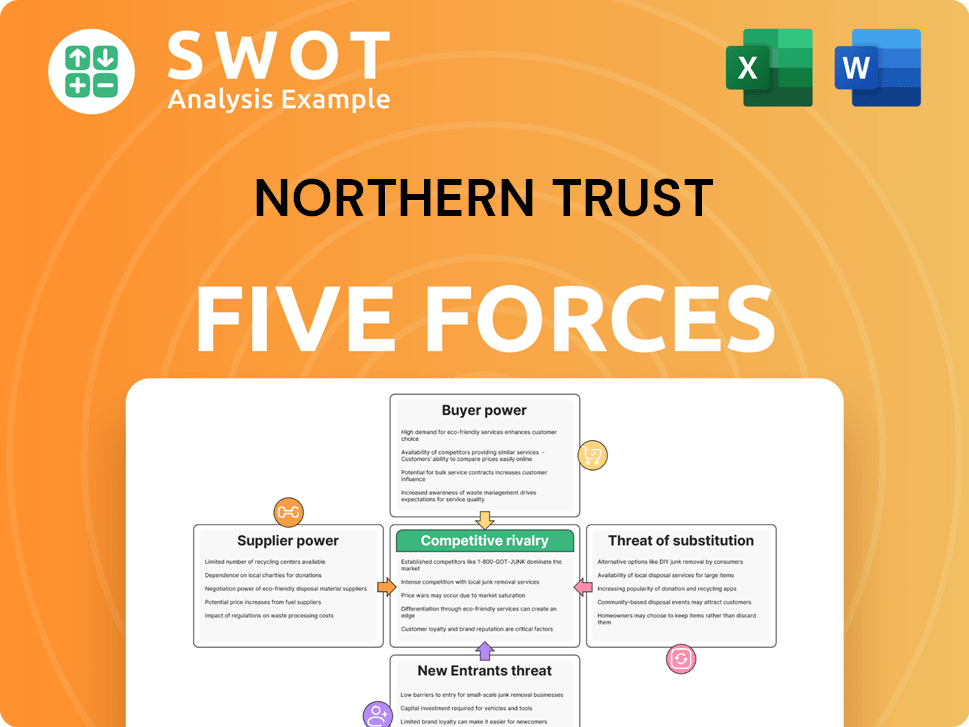
Related Blogs
- What are Mission Vision & Core Values of Northern Trust Company?
- What is Competitive Landscape of Northern Trust Company?
- What is Growth Strategy and Future Prospects of Northern Trust Company?
- How Does Northern Trust Company Work?
- What is Sales and Marketing Strategy of Northern Trust Company?
- What is Brief History of Northern Trust Company?
- What is Customer Demographics and Target Market of Northern Trust Company?
Disclaimer
All information, articles, and product details provided on this website are for general informational and educational purposes only. We do not claim any ownership over, nor do we intend to infringe upon, any trademarks, copyrights, logos, brand names, or other intellectual property mentioned or depicted on this site. Such intellectual property remains the property of its respective owners, and any references here are made solely for identification or informational purposes, without implying any affiliation, endorsement, or partnership.
We make no representations or warranties, express or implied, regarding the accuracy, completeness, or suitability of any content or products presented. Nothing on this website should be construed as legal, tax, investment, financial, medical, or other professional advice. In addition, no part of this site—including articles or product references—constitutes a solicitation, recommendation, endorsement, advertisement, or offer to buy or sell any securities, franchises, or other financial instruments, particularly in jurisdictions where such activity would be unlawful.
All content is of a general nature and may not address the specific circumstances of any individual or entity. It is not a substitute for professional advice or services. Any actions you take based on the information provided here are strictly at your own risk. You accept full responsibility for any decisions or outcomes arising from your use of this website and agree to release us from any liability in connection with your use of, or reliance upon, the content or products found herein.